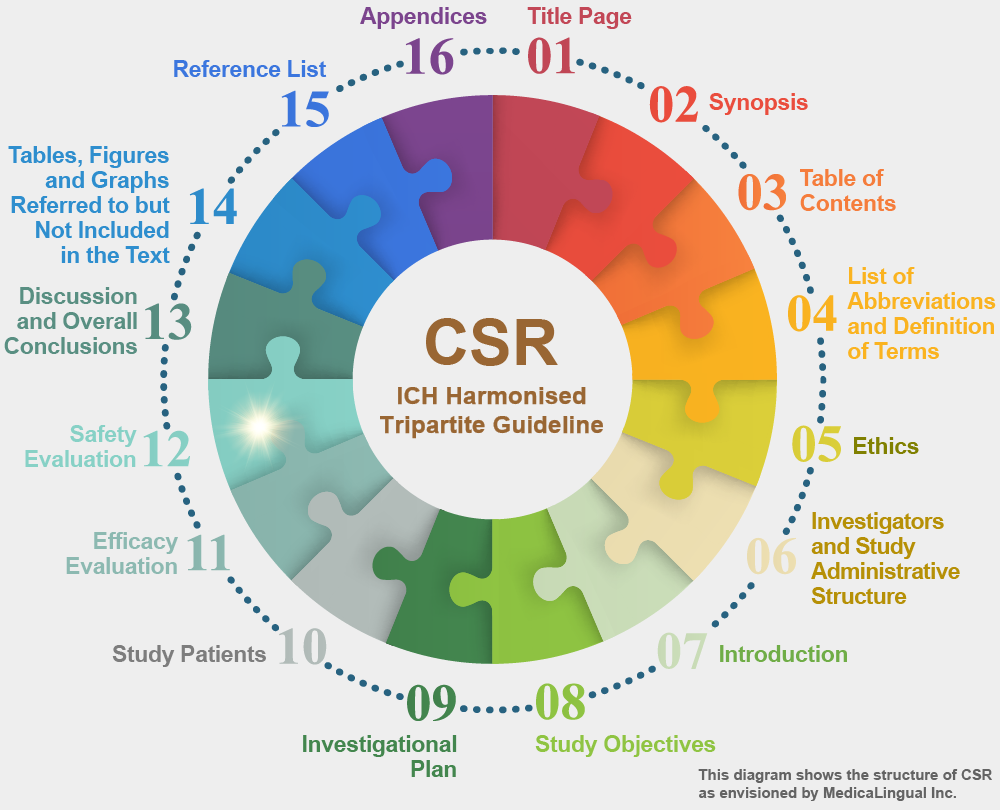
治験の統括報告書の構成と内容に関するガイドライン
平成8年5月1日 薬審第335号
各都道府県衛生主管部(局)長あて 厚生省薬務局審査課長通知
STRUCTURE AND CONTENT OF CLINICAL STUDY REPORTS
Recommended for Adoption at Step 4 of the ICH Process on 30 November 1995 by the ICH Steering Committee
12. 安全性の評価
安全性に関するデータの分析は三段階に分けて考えることができる。まず,治験からどの程度まで安全性を評価し得るのかを確認するために,投与量・期間・患者数を検討すること。次に,比較的よく見られる有害事象,臨床検査値の変化などを明確にし,妥当な方法で分類し,治療群間で比較を行い,さらに時間依存性,人口統計学的特性との関係,用量又は薬物濃度との関係など,副作用又は有害事象の頻度に影響する可能性のある因子について適切に分析すること。最後に,重篤な有害事象及び他の重要な有害事象を明確にすること。これは,通常,薬剤との関連が明確であるかどうかにかかわらず,有害事象のために試験完了前に脱落又は死亡した患者を十分に調べることにより検討される。
12. SAFETY EVALUATION
Analysis of safety-related data can be considered at three levels. First, the extent of exposure (dose, duration, number of patients) should be examined to determine the degree to which safety can be assessed from the study. Second, the more common adverse events, laboratory test changes etc. should be identified, classified in some reasonable way, compared for treatment groups, and analysed, as appropriate, for factors that may affect the frequency of adverse reactions/events, such as time dependence, relation to demographic characteristics, relation to dose or drug concentration etc. Finally, serious adverse events and other significant adverse events should be identified, usually by close examination of patients who left the study prematurely because of an adverse event, whether or not identified as drug related, or who died.
「治験中に得られる安全性情報の取扱いについて」に関するICH ガイドラインでは,重篤な有害事象が次のように定義されている。重篤な有害事象又は副作用とは,医薬品が投与された(投与量にかかわらない)際に生じたあらゆる好ましくない医療上のできごとのうち,死に至るもの,生命を脅かすもの,治療のため入院又は入院期間の延長が必要となるもの,永続的又は顕著な障害・機能不全に陥るもの,先天異常を来すものである。
The ICH Guideline on Clinical Safety Data Management, Definitions and Standards for Expedited Reporting defines serious adverse events as follows: a “serious adverse event” (experience) or reaction is any untoward medical occurrence that at any dose: results in death, is life-threatening, requires inpatient hospitalisation or prolongation of existing hospitalisation, results in persistent or significant disability/incapacity, or is a congenital anomaly/birth defect.
このガイドラインの意図するところでは,「その他の重要な有害事象」には,著しい血液学的異常や他の臨床検査値異常,及び薬剤治療の中止や減量又は重要な併用療法の追加などの治療方法の変更に至った全ての医学上の事象が含まれる。
For the purpose of this guideline, “other significant adverse events” are marked haematological and other laboratory abnormalities and any adverse events that led to an intervention, including withdrawal of drug treatment, dose reduction or significant additional concomitant therapy.
後述の節では,三種類の分析及び表示が求められる。つまり,
1)報告書の本文中にしばしば表や図を用いて示すことができる要約したデータ
2)個々の患者データの一覧表
3)特に関心のある事象についての文章による記述
である。
全ての一覧表及び分析において,被験薬と対照治療のいずれかに関連している事象を表示すること。
In the following sections, three kinds of analysis and display are called for:
1) summarised data, often using tables and graphical presentations presented in the main body of the report
2) listings of individual patient data, and
3) narrative statements of events of particular interest.
In all tabulations and analyses, events associated with both test drug and control treatment should be displayed.
ガイドライン ― Q&A
安全性評価
Q15:安全性評価の項では,死亡例の表,他の重篤な有害事象発現例の表,他の重要な有害事象発現例の一覧表などが必要であるが,一部の症例については複数の表に重複して含まれるのか。
A15:ガイドラインでは,有害事象の重大さについて,(1)死亡、(2)重篤な有害事象及び(3)重要な有害事象を区別している。概念としては,重篤な有害事象には死亡が含まれ,重要な有害事象には重篤な有害事象が含まれるという入れ子構造になっている。
ガイドライン本文においては,死亡例ではない重篤な有害事象発現例の一覧表や,重篤な有害事象ではない重要な有害事象発現例の一覧表を要求しているから,一つの有害事象については同一症例が重複して含まれることはないはずである。一症例に複数の有害事象が発現し,それらの重大さが異なるのであれば,当然複数の表に含まれることになる。
ここで重要なことは,報告書の読者すなわち審査官が,それぞれの重大さごとに整理された有害事象の発現例の明示を要求していることである。それ故,もし対象となる有害事象発現例を少ないのであれば,3つの表を作る代わりに重要な有害事象発現例の一覧表のみを作成して,その中で死亡例と重篤な有害事象発現例とを区別し明示するということでもよい。
Q16:症例一覧表には2つの形式があるという理解でよいか。
A16:一つの症例の情報をコンパクトに集めた形式(いわば症例記録の要約)と,複数の症例の情報を作表した形式(例えば,項目を横に,症例を縦に並べた表)の2通りの表があり,どの一覧表にどの形式を用いるべきかはガイドライン本文に示されている。
***










